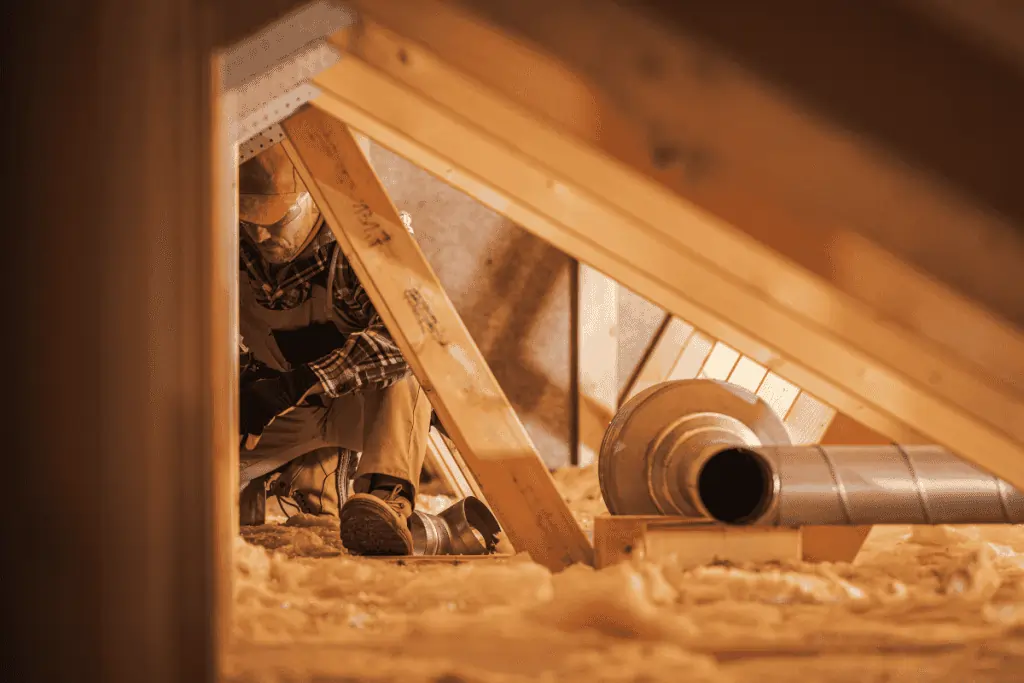Considering attic fans pros and cons to enhance your home’s comfort and efficiency? As homeowners, we all experience heat buildup in our attics, especially during those hot summer months. This can lead to increased energy costs and potential roof damage. But what exactly are attic fans, and how do they contribute to effective attic ventilation?
In this blog post, we will explore the pros and cons of attic fans, shedding light on their role in home cooling and overall energy efficiency.
Attic fans serve as a vital part of a well-ventilated home, helping to regulate temperatures and improve air quality. They work by expelling hot air from the attic, thereby reducing the strain on your air conditioning system and lowering your energy bills.
Moreover, we’ll discuss essential aspects like installation and alternative solutions that might suit your needs. Have you ever thought about how much heat your attic retains? Or how an attic fan could impact your home’s overall comfort?
By the end of this article, you’ll have a clear understanding of whether an attic fan is the right choice for your home. So, let’s dive into the details and discover how attic fans can make a difference in your living space.
Section 1: Understanding Attic Fans
To truly appreciate the role of attic fans, it’s essential to understand what they are and how they work. Attic fans are mechanical devices installed in the attic space, designed to expel hot air and draw in cooler outside air. This process enhances attic ventilation, which is crucial for maintaining a balanced temperature in your home.
Attic Fans Pros and Cons
When considering home improvements, examining the attic fans usage is vital for making an informed decision.
What is an Attic Fan?
At its core, an attic fan functions as a ventilator. It operates by reducing heat buildup in the attic, especially during sweltering summer months. By doing so, it helps regulate indoor temperatures, making your home more comfortable and potentially lowering your energy costs.
Attic fans can be beneficial for homes in regions that experience significant temperature fluctuations. They help maintain a stable environment by preventing excessive heat retention, which can lead to discomfort and higher energy consumption.
Types of Attic Fans
There are two main types of attic fans:
- Electric Attic Fans: These are powered by electricity and can be controlled via a thermostat or manually. While they effectively reduce heat buildup, they may contribute to higher energy bills if used excessively.
- Solar-Powered Attic Fans: These environmentally friendly options use solar panels to operate, reducing energy costs significantly. They harness sunlight to power the fan, making them an excellent choice for sustainability-minded homeowners.
Choosing between these types often depends on your budget, environmental concerns, and specific cooling needs.
How Do Attic Fans Work?
Attic fans work by creating a flow of air through the attic space. This process involves:
- Drawing hot air out: As the fan turns on, it expels warm air from the attic.
- Pulling in cooler air: This creates a vacuum effect that draws cooler air from outside into the attic space.
This cycle not only lowers the temperature in the attic but also helps maintain a balanced airflow throughout your home. Proper attic ventilation is essential not just for comfort but also for preventing potential damage to your roofing materials.
 Benefits of Attic Fans
Benefits of Attic Fans
Installing an attic fan can offer several advantages:
- Improved air circulation: Enhanced airflow prevents stale air from accumulating in your attic, which can lead to mold growth and other issues.
- Energy efficiency: By reducing reliance on air conditioning systems, attic fans can lower overall energy costs significantly.
- Extended roof lifespan: By preventing excessive heat buildup, attic fans help reduce the risk of roof damage due to prolonged exposure to high temperatures.
- Enhanced indoor comfort: With improved air circulation, you’ll notice a more consistent temperature throughout your home.
Understanding these fundamental aspects of attic fans can help you make an informed decision about their installation in your home.
To better understand the importance of ventilation in attics, check out this detailed guide on attic ventilation from Natural Resources Canada.
In conclusion, deciding whether to install an attic fan involves weighing its pros and cons against your specific needs. These devices play a significant role in attic ventilation, helping to alleviate heat buildup and improve home cooling during those hot summer months. While there are upfront installation costs to consider, the long-term benefits—such as reduced energy costs and prolonged roof life—often outweigh these initial expenses.
Consider how an attic fan could enhance your home’s comfort and energy efficiency. Have you experienced issues with heat buildup or high energy bills? Perhaps it’s time to explore this solution further.
If you’re looking for a way to improve your home’s ventilation system without extensive renovations, an attic fan may be worth considering.
Ultimately, choosing the right ventilation strategy will ensure your home remains a comfortable haven year-round. With a clearer understanding of how attic fans function and their numerous benefits, you can make an informed choice that meets both your comfort needs and budget.
If you’re ready to take the next step toward enhancing your home’s comfort and efficiency, visit our Services page to learn how we can help you with your attic fan installation and other ventilation solutions.
Armour Shield Roofing strongly discourages homeowners from going up and down ladders or doing repairs on their roofs. The accidents and fatalities sustained by untrained individuals are tragic and avoidable by calling a professional roofing contractor.


 Benefits of Attic Fans
Benefits of Attic Fans